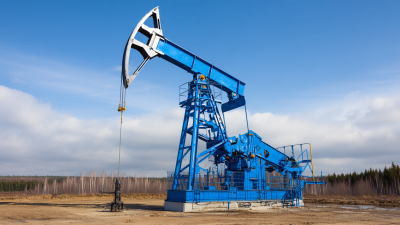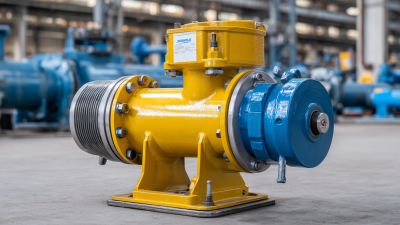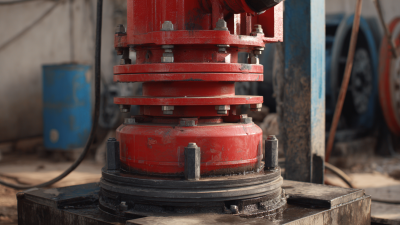How to Optimize Production with Artificial Lift Pumps: Enhancing Efficiency in Oil Wells
In the ever-evolving landscape of the oil and gas industry, optimizing production efficiency is paramount for maximizing output and profitability. One of the most effective ways to achieve this goal is through the strategic use of artificial lift pumps. These systems play a crucial role in enhancing the flow of hydrocarbons from wells, especially in mature fields where natural reservoir pressure has diminished. By providing the necessary lift to bring oil to the surface, artificial lift pumps can significantly boost production rates while also prolonging the life of the well.

This article will explore various methodologies and best practices for optimizing the performance of artificial lift pumps, focusing on techniques that can improve system efficiency, reduce operational costs, and ultimately increase the return on investment for oil operators. Whether you are a seasoned professional or new to the industry, understanding how to optimize artificial lift pump operations is essential for driving success in today’s competitive market.
Choosing the Right Type of Artificial Lift Pump for Your Oil Wells
Choosing the right type of artificial lift pump for your oil wells is crucial for optimizing production and enhancing efficiency. Various types of artificial lift systems, such as rod pumps, electric submersible pumps, and gas lift systems, are designed for specific conditions and production rates. Understanding the characteristics of your well, including its depth, fluid composition, and production goals, will guide you in selecting the appropriate pump.
**Tips:** Always evaluate the well's operational conditions. For instance, rod pumps work well in shallow wells with low fluid rates, while electric submersible pumps are ideal for deeper wells and higher production rates. Conducting a cost-benefit analysis can also help you determine which system will provide the best return on investment.
Additionally, consider the maintenance requirements of each pump type. Some systems may require frequent service, while others can operate efficiently for extended periods with minimal intervention. Monitoring the performance regularly will help identify issues early on, ensuring sustained productivity and efficiency.
How to Optimize Production with Artificial Lift Pumps: Enhancing Efficiency in Oil Wells - Choosing the Right Type of Artificial Lift Pump for Your Oil Wells
| Pump Type | Efficiency (%) | Depth Range (meters) | Recommended Application | Maintenance Frequency (months) |
|---|---|---|---|---|
| Rod Pump | 85 | 200 - 2000 | Conventional wells | 6 |
| Electrical Submersible Pump (ESP) | 90 | 300 - 4000 | High production rates | 12 |
| Progressing Cavity Pump (PCP) | 80 | 100 - 3000 | Viscous fluids | 9 |
| Gas Lift | 75 | 200 - 3000 | Wells with gas | 4 |
| Plunger Lift | 78 | 100 - 1500 | Intermittent flow | 6 |
Understanding the Operational Mechanisms of Different Pump Systems
Artificial lift pumps play a critical role in enhancing oil production efficiency by utilizing various operational mechanisms tailored to different well conditions. Understanding these mechanisms is essential for optimizing performance in oil wells. For instance, progressive cavity pumps (PCPs) operate on a helical rotor design that facilitates continuous fluid transport, making them favorable for low production rates. Recent advancements have led to the development of high-efficiency lift systems, where optimization of the pump’s operational parameters can lead to significant gains in output. Industry reports indicate that using advanced telemetry and monitoring technologies can improve the operational efficiency of these systems by up to 15%, thus reducing downtime and operational costs.
Another avenue for optimization lies in the integration of renewable energy sources in hydraulic systems, as seen in modern water pumping applications. Technologies that harness geothermal energy for pumping and production have demonstrated potential efficiency gains, with some studies suggesting that these systems can operate with up to 30% greater efficiency compared to traditional methods. The ongoing research into hybrid renewable energy water pumping systems illustrates how strategic combination with solar or wind power can not only enhance energy efficiency but also contribute to sustainable practices in oil extraction. By prioritizing the understanding of various pump mechanisms and integrating innovative technologies, the oil and gas industry can significantly enhance production outcomes while mitigating environmental impacts.
Optimizing Pump Performance through Regular Maintenance and Monitoring
 Regular maintenance and monitoring are crucial for optimizing the performance of artificial lift pumps used in oil wells. These pumps significantly contribute to enhancing production efficiency, but their effectiveness hinges on routine care and timely interventions.
Scheduled inspections help identify wear and tear, ensuring that any potential issues are addressed before they escalate into costly failures. This proactive approach minimizes downtime, which is vital in maintaining a steady output of oil.
Regular maintenance and monitoring are crucial for optimizing the performance of artificial lift pumps used in oil wells. These pumps significantly contribute to enhancing production efficiency, but their effectiveness hinges on routine care and timely interventions.
Scheduled inspections help identify wear and tear, ensuring that any potential issues are addressed before they escalate into costly failures. This proactive approach minimizes downtime, which is vital in maintaining a steady output of oil.
Moreover, implementing a robust monitoring system allows operators to analyze key performance metrics in real time. By tracking parameters such as flow rates, pressures, and temperatures, operators can detect anomalies early, enabling swift corrective actions. Advanced monitoring technologies, such as IoT sensors and predictive analytics, provide valuable insights into pump performance, leading to informed decisions about operational adjustments. By prioritizing maintenance and employing effective monitoring strategies, oil producers can significantly enhance the reliability and efficiency of artificial lift systems, ultimately maximizing production outcomes.
Implementing Advanced Technologies to Enhance Pump Efficiency
Implementing advanced technologies in artificial lift systems is crucial for enhancing pump efficiency in oil wells. With the evolving demands in the oil industry, integrating smart technologies such as automation and real-time monitoring can provide significant advantages. These systems enable operators to optimize production rates by continuously assessing the performance of pumps and making necessary adjustments without human intervention. The use of sensors and IoT devices allows for the collection of valuable data that can be analyzed to predict potential failures and optimize maintenance schedules, thereby reducing downtime and operational costs.
Moreover, advancements in pump design, including efficient hydraulic designs and materials, can further enhance performance. By utilizing advanced software for modeling and simulation, operators can identify the optimal pump configurations for specific well conditions. This proactive approach ensures that the pumps operate within their best efficiency points, leading to improved fluid recovery rates and energy use. Ultimately, embracing these advanced technologies not only boosts productivity but also contributes to more sustainable and cost-effective operations in the competitive oil market.
Analyzing Production Data to Fine-Tune Lift Optimization Strategies
Analyzing production data is a critical step in optimizing the use of artificial lift pumps in oil wells. By closely examining key performance indicators such as flow rates, pressure levels, and pump efficiency, operators can identify patterns and trends that reveal opportunities for improvement. Advanced data analytics tools enable engineers to process vast amounts of production data, facilitating a more granular understanding of well performance over time. This comprehensive analysis helps to pinpoint specific issues, such as pump wear or suboptimal lift settings, allowing for targeted interventions that enhance overall efficiency.
Furthermore, fine-tuning lift optimization strategies involves the integration of real-time data monitoring systems. These systems provide immediate feedback on pump performance, enabling operators to make informed decisions about adjustments needed to maximize oil recovery. By continuously tracking various metrics, teams can swiftly respond to changes in downhole conditions or production dynamics, ensuring that artificial lift systems are always operating at peak performance. Ultimately, a data-driven approach to lift optimization not only improves production rates but also extends the lifespan of artificial lift equipment, resulting in significant cost savings for oil operators.

Related Posts
-

5 Best Artificial Lift Pumps Revolutionizing Oil Recovery: Boost Efficiency and Cut Costs
-

How to Choose the Right Solution Pump for Your Business Needs
-

Ultimate Guide to Choosing the Right Oil Jet Pump for Your Industry Needs
-

7 Best Practices to Maximize Efficiency of Your Well Pressure Pump
-

Mastering Sucker Rod Pump Efficiency through Advanced Techniques and Industry Insights
-

Streamlining Efficiency: Innovative Solutions for Gas Well Pump Operations in Oil and Gas Industry
